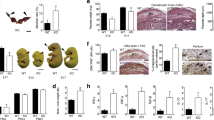Abstract
The objective of this study was to investigate the expression of netrin-1 in placenta from patients with fetal growth restriction (FGR) and its effect on the viability and apoptosis of human placental microvascular endothelial cells. Thirty-three patients with FGR (including eighteen severe cases) and twenty-four normal late pregnant women were investigated. The expression of netrin-1 in placental tissues was detected by employing immunohistochemistry, real-time PCR, and Western blotting. Human placental microvascular endothelial cells were isolated and, after treatment with netrin-1, examined for their viability and apoptosis by using MTT assay and flow cytometry. We demonstrated that the netrin-1 was present in placenta. Netrin-1 was significantly reduced in pregnant women with FGR as compared with the controls. Furthermore, netrin-1 enhanced the viability of human placental microvascular endothelial cells and inhibited their apoptosis. Netrin-1 may regulate the development of placental vessels and plays a key role in the pathogenesis of FGR.



Similar content being viewed by others
References
Yanney M, Marlow N (2004) Paediatric consequences of fetal growth restriction. Semin Fetal Neonatal Med 9:411–418
Crispi F, Bijnens B, Figueras F et al (2010) Fetal growth restriction results in remodeled and less efficient hearts in children. Circulation 121:2427–2436
Maulik D, Frances Evans J, Ragolia L (2006) Fetal growth restriction: pathogenic mechanisms. Clin Obstet Gynecol 49:219–227
Chinni E, Colaizzo D, Tiscia GL et al (2010) Markers of haemostasis and angiogenesis in placentae from gestational vascular complications: impairment of mechanisms involved in maintaining intervillous blood flow. Thromb Res 125:267–271
Arroyo JA, Winn VD (2008) Vasculogenesis and angiogenesis in the IUGR placenta. Semin Perinatol 32:172–177
Barut F, Barut A, Gun BD (2010) Intrauterine growth restriction and placental angiogenesis. Diagn Pathol 22:24
Tsai HH, Macklin WB, Miller RH (2006) Netrin-1 is required for the normal development of spinal cord oligodendrocytes. J Neurosci 26:1913–1922
Murakami S, Ohki-Hamazaki H, Watanabe K et al (2010) Netrin-1 provides a chemoattractive cue for the ventral migration of GnRH neurons in the chick forebrain. J Comp Neurol 518:2019–2034
Park KW, Crouse D, Lee M et al (2004) The axonal attractant Netrin-1 is an angiogenic factor. Proc Natl Acad Sci 101:16210–16215
Cristofaro B, Emanueli C (2009) Possible novel targets for therapeutic angiogenesis. Curr Opin Pharmacol 9:102–108
Dakouane-Giudicelli M, Duboucher C, Fortemps J et al (2010) Characterization and expression of netrin-1 and its receptors UNC5B and DCC in human placenta. J Histochem Cytochem 58:73–82
Lian IA, Toft JH, Olsen GD et al (2010) Matrix metalloproteinase 1 in pre-eclampsia and fetal growth restriction: reduced gene expression in decidual tissue and protein expression in extravillous trophoblasts. Placenta 31:615–620
Murthi P, Doherty V, Said J et al (2006) Homeobox gene HLX1 expression is decreased in idiopathic human fetal growth restriction. Am J Pathol 168:511–518
Kusinski LC, Baker PN, Sibley CP et al (2009) In vitro assessment of mouse uterine and fetoplacental vascular function. Reprod Sci 16:740–748
Baschat AA (2010) Fetal growth restriction—from observation to intervention. J Perinat Med 38:239–246
Rabe N, Gezelius H, Vallstedt A et al (2009) Netrin-1-dependent spinal interneuron subtypes are required for the formation of left-right alternating locomotor circuitry. J Neurosci 29:15642–15649
Masuda T, Watanabe K, Sakuma C et al (2008) Netrin-1 acts as a repulsive guidance cue for sensory axonal projections toward the spinal cord. J Neurosci 28:10380–10385
Cirulli V, Yebra M (2007) Netrins: beyond the brain. Nat Rev Mol Cell Biol 8:296–306
Wilson BD, Ii M, Park KW et al (2006) Netrins promote developmental and therapeutic angiogenesis. Science 313:640–644
Sherer DM, Abulafia O (2001) Angiogenesis during implantation, and placental and early embryonic development. Placenta 22:1–13
Acknowledgments
This work was supported by a grant from the National Natural Science Foundation of China (No. 30872776).
Author information
Authors and Affiliations
Corresponding author
Rights and permissions
About this article
Cite this article
Qian-hua, W., Shao-ping, Z., Jian-wen, Z. et al. Reduced expression of netrin-1 is associated with fetal growth restriction. Mol Cell Biochem 350, 81–87 (2011). https://doi.org/10.1007/s11010-010-0684-2
Received:
Accepted:
Published:
Issue Date:
DOI: https://doi.org/10.1007/s11010-010-0684-2




